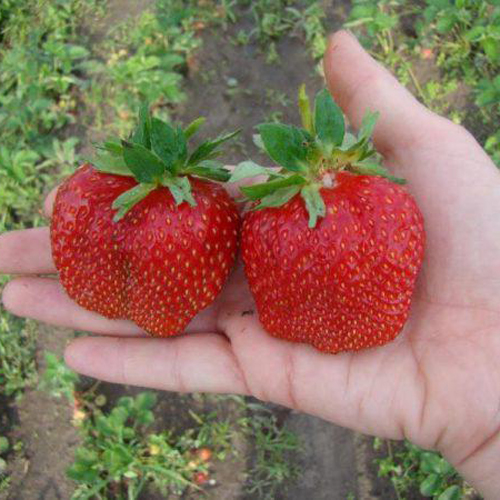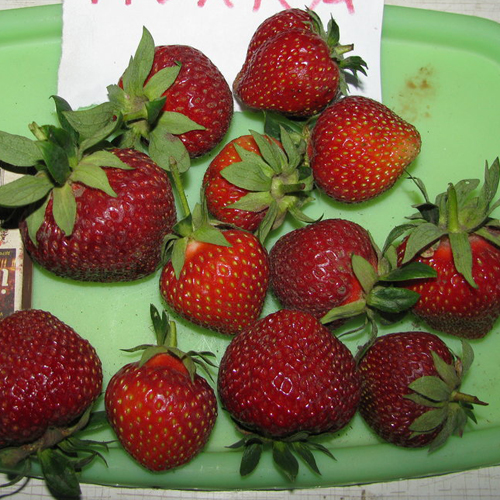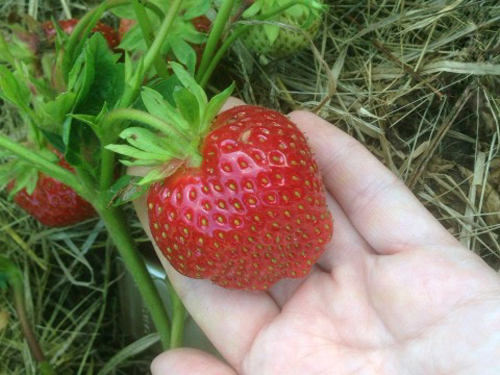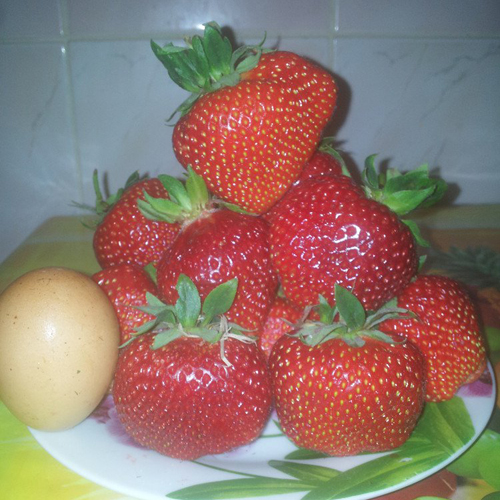Strawberry variety Polka (Polka)
The shelf is a non-renovated medium-ripening strawberry variety. It was bred by Dutch breeders in 1977 by crossing the Induka and Sivetta varieties. Differs in good taste and excellent presentation of berries, high drought resistance and unpretentious care. Strawberries are suitable for cultivation in Central Russia, Ukraine and Belarus, popular in the Baltic countries.

The plant is of medium height, vigorous, looks very compact. Whiskers are abundant; in the heat, the number of whiskers decreases. The leaves are large, medium-wrinkled, bright green in color. A feature of the variety is that the leaf has four or five lobes. By the way, this varietal trait was passed on to the descendant of our heroine - Sonata (Shelf x Elsanta). Strawberry flowers are white. Peduncles are located at the level of leaves, under the weight of the fruit they are laid on the ground.

The berries are conical in shape, sometimes with a flattened tip. The skin is bright red, shiny, at the stage of full maturity it acquires a dark brownish tint. Fruits, as they ripen, are evenly colored, starting from the sepal. The pulp is light red in color, dense, juicy, without voids, with a pleasant aroma. Berries of the Shelf have an excellent taste, it is predominantly sweet, but there is also a slight appropriate sourness. There are also notes of caramel in the taste palette.

Strawberries are versatile in use, especially good fresh, suitable for any kind of processing, and suitable for freezing. Due to the dense structure of the pulp, the berries of this variety perfectly tolerate transportation, do not wrinkle and do not flow, while maintaining an excellent appearance. It is worth mentioning that the Shelf is famous for its uniformity of fruit shapes, which makes it especially attractive to buyers in the market. But it should also be said that the fruiting of our heroine is unstable, and after the first harvest, the berries begin to shrink, so there is no question of evenness of fruits by weight.

The average weight of berries is about 30 grams, during the first harvest, the indicator fluctuates at the level of 35-40 grams, the largest specimens weigh 50-60 grams, with subsequent harvests the weight gradually decreases, reaching 20 grams or less. It is worth saying that many gardeners are unhappy with the size of the berries of this variety, their weight often does not correspond to the declared one. However, the weight of the fruits is influenced by agricultural technology, as well as the age of the plants and the weather conditions of the season.

Strawberries ripen on average, around mid-June, but they can start bearing fruit earlier or later, depending on the growing region and weather conditions. The yield at Polka is average, one might even say very low - about 350-400 grams of fruit per bush, about 1.2-1.3 kg per square meter. Some sources state that the yield of strawberries can reach 2 kg per plant, but this information is very controversial and most likely incorrect. It should be understood that the variety was bred for a long time, moreover, it is not repaired, therefore it cannot compete with the modern "giants" of the strawberry market. And the yield of 2 kg per bush is already a very serious indicator, which not every "giant" can produce. In addition, according to the reviews of gardeners, our heroine is revered for her other characteristics, and the amount of harvest is not her dignity.
Plants are resistant to fungal diseases, including powdery mildew, and are also rarely affected by pests. Strawberries are moderately resistant to root system diseases. It is still highly desirable to carry out all the necessary preventive measures. Polka's winter hardiness is average; in regions with frosty winters with little snow, it requires good shelter. By the way, gardeners note that the variety is quite "tenacious" and is capable of recovering from various weather disasters, including after freezing in winter.What our heroine can bravely boast of is drought resistance and heat resistance. Even in the driest and hottest seasons, the variety feels very comfortable. However, it should be said that in such conditions the taste of the berries will deteriorate noticeably - it will become excessively sour. Also, voids can form inside the berries, and the fruits themselves will be smaller. To avoid these incidents, it is enough to simply provide the plants with regular abundant watering.
In agricultural technology, the Regiment is quite simple, but it has some peculiarities. And often gardeners refuse it, simply not being able to pick up a "key" for it. Consider the main nuances of growing and care in the list below.
- Strawberries react extremely negatively to thickening, so the bushes should be planted at a distance of at least 30-35 cm from each other.
- Planting is carried out in August, optimally at the end of July, if the weather permits - young, newly planted plants do not tolerate heat well, as well as cold.
- The variety can be grown both outdoors and indoors. At the same time, under the shelters, the Regiment will begin to bear fruit a little earlier.
- Strawberries are hygrophilous, do not skimp on watering. Just do not overdo it - excessive waterlogging of the soil threatens to increase the risk of infection of plants with fungal diseases, moreover, the berries can rot.
- It is highly advisable to use mulch, as the fruits often lie on the ground, as a result of which they can begin to rot.
- The variety does not need an increased amount of fertilizers, but nevertheless, regular high-quality feeding has a positive effect on the yield of the variety and the taste of the berries. Organic matter is introduced before planting strawberries and until flowering, then preference is given to mineral complexes, and special attention should be paid to them. The fact is that with a lack of micro- and macroelements in the soil, the palatability of the fruits can deteriorate significantly - the berries will become too sour and dryish. Foliar feeding takes place.
- A feature, and at the same time a disadvantage of the Shelf, is the rapid loss of varietal traits. So, the variety reaches the peak of its productivity in the first year of fruiting, the next year the yield decreases slightly, and in the third year it is completely nonexistent. Thus, it is advisable to grow our heroine only in a one- or two-year culture, and then renew the planting. Many gardeners, who neglect the rejuvenation of the plantation, complain about too low yields and outright trifles instead of normal berries on the bushes. Well, the problem has a very understandable cause.
Let's briefly summarize. Over the long years of its existence, this strawberry has managed to acquire a large number of positive reviews. However, we can safely say that at the moment the variety is considered obsolete. Productivity - falls short of modern standards; taste - breeders brought out specimens and tastier; drought resistance is not so important in the conditions of automated cultivation technology. But despite all this, not only gardeners, but also farmers continue to use the Shelf. Although it is not stable, it does not require abundant feeding and painstaking care. Although its berries are not gigantic, there are quite a few of them on the bush, which provides a satisfactory yield. Of course, for commercial purposes, it is better to look at a different variety, more productive and reliable. And for herself and her family, our heroine is quite suitable.









Of all the varieties (more than 50) tasted on our own site over the past 6 years, Polka is the most delicious, even if it is at least a hundred times outdated. And Kimberly with its "caramel" taste, and Syria with Asia, and Flair, and Garigat, and others, others are just "just a berry", due to the commercial orientation in many respects the same. Sometimes it is very tasty and peculiar, but there are few of them. Plus, they often can't stand my climate conditions - they freeze. And Polka is just caramel, very sweet, the pulp is not hard, the berry is large, fragrant ... It is outdated in terms of resistance to sores, here, yes, there are many superior ones. It must be fed and processed. It vomits out in "rotten" winters, freezes out in very severe frosts, but not 100%. But I won't give it up for the taste and I will try to negotiate with her
Thanks for the clarification about the annual crop, somehow I thought that it is the same as most of the old varieties and can easily sit in one place for several years.